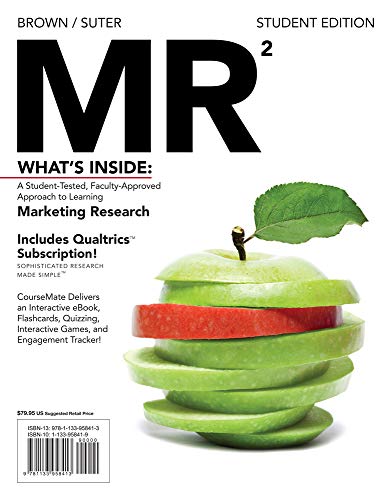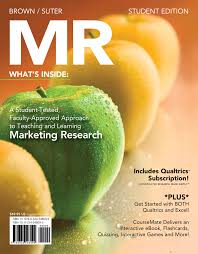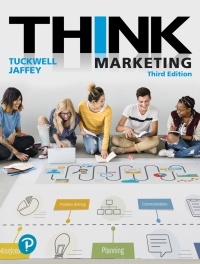Description
Test Bank For MR2, 2nd Edition by Tom J. Brown
Chapter 2—The Research Question: Formulation of the Problem
MULTIPLE CHOICE
1. The two fundamental sources of marketing research problems are:
a.
planned change and unplanned change.
b.
ineffective advertising and change.
c.
poor sales and ineffective advertising.
d.
poor management and unplanned change.
e.
technological advancement and customer suggestions.
ANS:APTS:1
NAT:AACSB Analytic | CB&E Model Research | Bloom’s: Knowledge
2.Which of the following is FALSE?
a.
Serendipity is synonymous with planned change.
b.
Strategy-oriented decision problems focus on selecting alternative courses of action.
c.
The marketing problem should be defined clearly so that research can be designed properly.
d.
Change is a fundamental source of marketing problems.
e.
Discovery-oriented problems are common with unplanned changes in the marketing environment.
ANS:APTS:1
NAT: AACSB Analytic | CB&E Model Research | Bloom’s: Comprehension
3.The main purpose of marketing research brought about by planned change is to:
a.
decide how to implement the change.
b.
find out what is happening and why.
c.
describe changes in the internal environment.
d.
describe changes in the external environment.
e.
explore the possible causes of the change.
ANS:APTS:1
NAT:AACSB Analytic | CB&E Model Research | Bloom’s: Knowledge
4.The main purpose of discovery-oriented marketing research is to:
a.
decide what to do about a planned change.
b.
find out what is happening and why.
c.
try out a new product in a test market.
d.
describe changes in the internal environment.
e.
capture and evaluate a new idea.
ANS:BPTS:1
NAT:AACSB Analytic | CB&E Model Research | Bloom’s: Analysis
5.Which of the following is TRUE?
a.
Many managers cannot clearly and precisely state the nature of the decision problem they want investigated.
b.
Managers do not need to be actively involved in the marketing research process.
c.
If a decision-maker will not change his decision regardless of the result of the research, the research should still be conducted for informational purposes.
d.
A researcher should not worry about the decision alternatives as decision-makers typically provide researchers with a complete list of them.
e.
All of the above statements are true.
ANS:APTS:1
NAT: AACSB Analytic | CB&E Model Research | Bloom’s: Comprehension
6.Research problems might arise from:
a.
unanticipated change in the marketing environment.
b.
a firm’s planned change of a marketing variable.
c.
customer complaint letters and salepeople’s reports.
d.
both a and c.
e.
a, b and c.
ANS:EPTS:1
NAT: AACSB Analytic | CB&E Model Research | Bloom’s: Comprehension
7.Serendipity, or chance ideas, as a source of marketing research problems, might arise from:
a.
customer complaint letters.
b.
salesperson’s call reports.
c.
comments in trade publications.
d.
customer calls to assistance centers.
e.
all of the above.
ANS:EPTS:1
NAT: AACSB Analytic | CB&E Model Research | Bloom’s: Comprehension
8.Which of the following is TRUE?
a.
The decision problem is synonymous with the research problem.
b.
The decision problem involves determining what information to provide and how that information can best be secured.
c.
The decision problem focuses on the problem or opportunity from the manager’s perspective while the research problem focuses on the problem as viewed by the researcher.
d.
The research problem focuses on what action needs to be taken while the decision problem focuses on what information to provide and how that information can best be secured.
e.
All of the above statements are true.
ANS:CPTS:1
NAT:AACSB Analytic | CB&E Model Research | Bloom’s: Knowledge
9.A research request agreement includes all of the following items, EXCEPT:
a.
an analysis of the results of the research process.
b.
the decision problem confronting the manager.
c.
the target population from which a sample will be drawn.
d.
an approximation of the time and expense of the research report.
e.
the way each piece of information will be used.
ANS:APTS:1
NAT:AACSB Analytic | CB&E Model Research | Bloom’s: Knowledge
10.Which of the following statements is FALSE?
a.
Under normal circumstances, poor problem formulation can be rescued by more sophisticated statistical analyses.
b.
Misdefining the problem or opportunity can produce disastrous results for companies.
c.
The best way to avoid researching the wrong problem is to delay the research until the problem is properly defined.
d.
A “problem” confronting a company might also be viewed as an opportunity, and vice versa.
e.
A research problem is merely a restatement of the decision problem in research terms, from the researcher’s perspective.
ANS:APTS:1
NAT: AACSB Analytic | CB&E Model Research | Bloom’s: Comprehension
11.It is important to meet with the client at the earliest stages of the research project so that:
a.
an appropriate budget can be established.
b.
the researcher(s) and client can begin to develop rapport and trust.
c.
research methods can be selected in time to meet project deadlines.
d.
the researcher(s) can get as much background information as possible.
e.
Both b and d
ANS:EPTS:1
NAT: AACSB Analytic | CB&E Model Research | Bloom’s: Comprehension
12.A customer service representative for a large financial institution noticed that several of the bank’s customers had recently closed accounts and paid off loans long before the loans were due. He also noticed that most of the customers had closed their accounts shortly after a competitor had opened a new branch nearby. The fundamental source of this marketing problem might best be described as:
a.
a planned change in the marketing environment.
b.
a discovery-oriented decision problem.
c.
an unplanned change in the marketing environment.
d.
all of the above.
e.
none of the above.
ANS:CPTS:1
NAT:AACSB Analytic | CB&E Model Research | Bloom’s: Application
13.A store manager seeking to discover why store revenues have fallen in the past two months is faced with:
a.
a discovery-oriented decision problem
b.
normal thinking
c.
a strategy-oriented decision problem
d.
serendipity
e.
none of the above.
ANS:APTS:1
NAT:AACSB Analytic | CB&E Model Research | Bloom’s: Knowledge
14.A store manager attempting to discover methods by which store revenue can be raised is faced with:
a.
a discovery-oriented decision problem.
b.
a promise problem.
c.
a conjugacy problem.
d.
a strategy-oriented decision problem.
e.
all of the above.
ANS:DPTS:1
NAT:AACSB Analytic | CB&E Model Research | Bloom’s: Application
15.Strategy-oriented decision problems are commonly used:
a.
with unplanned change.
b.
with planned change.
c.
to determine what is going on in a situation.
d.
to make a choice between strategic alternatives.
e.
Both b and d.
ANS:EPTS:1
NAT:AACSB Analytic | CB&E Model Research | Bloom’s: Knowledge
16.The research proposal:
a.
is used primarily to summarize the problem definition process.
b.
does not include proposed research methods.
c.
lays out the proposed method of conducting the research.
d.
is a request to a researcher who will study the problem.
e.
cannot be changed once it has been accepted by the manager.
ANS:CPTS:1
NAT:AACSB Analytic | CB&E Model Research | Bloom’s: Knowledge
17.Despite research proving that consumers preferred the taste of New Coke, its intorduction to the market was a failure because people did not want the old formulation to be discontinued. This failure could have been avoided if:
a.
researchers had concentrated on advocacy research.
b.
researchers had broadened the sample population.
c.
researchers had defined the problem differently.
d.
researchers had changed the method for the taste tests.
e.
researchers had focused on novelty rather than taste.
ANS:CPTS:1
NAT:AACSB Analytic | CB&E Model Research | Bloom’s: Analysis
18.A discovery-oriented decision problem is best defined as a:
a.
decision problem that typically seeks to answer “what” or “why” questions.
b.
restatement of the decision problem in research terms.
c.
decision problem that typically seeks to answer “how” questions.
d.
written statement that describes the marketing problem.
e.
All of the above.
ANS:APTS:1
NAT: AACSB Analytic | CB&E Model Research | Bloom’s: Comprehension
TRUE/FALSE
19.A strategy-oriented decision problem typically seeks to answer “how” questions about a problem/opportunity.
ANS:TPTS:1
NAT:AACSB Analytic | CB&E Model Research | Bloom’s: Knowledge
20.A research request agreement should only include the decision problem and the research problem.
ANS:FPTS:1
NAT:AACSB Analytic | CB&E Model Research | Bloom’s: Knowledge
21.Normal thinking is not always the best way to understand the true nature of a problem.
ANS:TPTS:1
NAT: AACSB Analytic | CB&E Model Research | Bloom’s: Comprehension
COMPLETION
22.A(n) ____________________ is a restatement of the decision problem in research terms, from the researcher’s perspective.
ANS: research problem
PTS: 1 NAT: AACSB Analytic | CB&E Model Research | Bloom’s: Knowledge
23.____________________ decision problems are common with unplanned changes in the marketing environment.
ANS: Discovery-oriented
PTS: 1 NAT: AACSB Analytic | CB&E Model Research | Bloom’s: Knowledge
24.A document that describes, as specifically as possible, the nature of the problem for which research is sought and that asks providers to offer proposals, including cost estimates, about how they would perform a job is called a(n) ____________________.
ANS: request for proposal
PTS: 1 NAT: AACSB Analytic | CB&E Model Research | Bloom’s: Knowledge
ESSAY
25.List all the points that should be included in a research request agreement.
ANS:
The research request agreement summarizes the problem formulation process and should include the following items: background, decision problem, research problem, use of data, population and subgroups from which data will be drawn, and the logistics of the research process.
PTS: 1 NAT: AACSB Analytic | CB&E Model Research | Bloom’s: Knowledge





Be the first to review “Test Bank For MR2, 2nd Edition by Tom J. Brown”